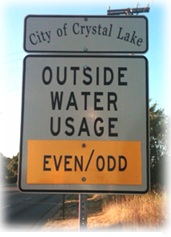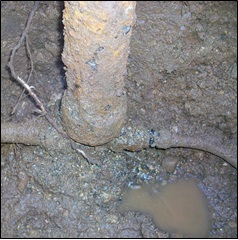
Flickr CC/Justin Chiaratti
 By Andrew Resek
By Andrew Resek - February 11, 2013
Experiencing Drought is a series of guest profiles by public works officials on the impacts of drought on northeastern Illinois communities. This is the fourth in the series, view other posts from the Experiencing Drought series. For more information, please contact Abby Crisostomo at acrisostomo@metroplanning.org.
Municipality: Crystal Lake, Ill.
Water Source: Deep and shallow groundwater aquifers
Issue: First real test of the city's new water conservation ordinance
Outcome: Ordinance succeeded in reducing water production during periods of drought
The drought of 2012 was troubling for communities all across northeast Illinois. The City of Crystal Lake in McHenry County received only 24.4 inches of rain through October of 2012. During the same period in 2011, the city accumulated 46.2 inches of rain. However, the drought provided the Water Division opportunities to observe how new dry weather practices responded to adverse conditions.

One of 12 Outside Water Status signs
posted on main arteries of Crystal Lake
The 2012 drought was the first good opportunity to test our Water Conservation Ordinance, which was adopted in 2009. The City has a three-color coded system to inform its residents when it is okay to use public water for outside activities, such as washing cars, watering lawns and gardens, and using slip-n’-slides. The City used several media outlets to spread the message of outside water usage restrictions, including the use of the City website, cable channel, and Twitter feed, in addition to strategically placed street signs.
When our water customers were close to using more water than we were capable of storing or treating, we asked residents to cut back on their consumption. We did this on June 25, 201,2 by changing the City’s water status to yellow, which meant that all outside water use was restricted to even or odd numbered days, based on the customer’s address number. Outside water use was also restricted to the hours of 5 a.m. to 8 a.m. and 6 p.m. to 9 p.m.
After months of restricting outside water use, we wanted to see if our conservation efforts deserved a pat on the back or if we needed to go back to the drawing board. Our result? It worked, but with some unintended consequences.
To see if the yellow status had any affect on water usage, we took a look at a similar drought in 2005 where the
city received about 26.4 inches of rain during the same period. We looked at how much water was produced in 2005 and compared it to our projected water production in 2012. We estimate the City will produce approximately 273 million fewer gallons of water during 2012 than it did in 2005.
We knew we had to take into account the effects of the economic downturn. The decreased production couldn’t totally be attributed to conservation alone. While the population of Crystal Lake has increased about 7 percent from 2005 to 2012, the number of “zero consumers” because of foreclosures has increased dramatically. Using the number of active accounts with no consumption, and assuming the average family of four uses approximately 10,000 gallons a month, we roughly estimated 20 million gallons of water conservation was simply due to properties sitting vacant during this time.
So what were the unintended consequences?
Water customers using less water this summer meant there was enough to go around during extended periods of hot, dry weather, but it also means our residents will not be paying for about 250 million gallons of water. This translates to approximately $1.3 million in lost revenue that is not available for the water utility’s budget.
Water is a commodity and we need our water customers to buy our product in order to pay for all kinds of things

Water main gives way in older portion of Crystal Lake’s distribution system
like:
- rehabilitating and replacing old and outdated treatment equipment, water mains, and fire hydrants;
- higher energy and chemical costs; and
- employee salaries.
The Environmental Protection Agency requires extensive water sample testing of the public drinking water supply. In order to maintain compliance, we need up-to-date treatment equipment and the staff available to collect and submit all of the required samples.
Diamonds might last forever, but water mains don’t. Given the lost revenue with mounting operational costs, the City may have to review the unpopular topic of increasing water rates.
While the drought of 2012 was a good test of what our water customers and our 2009 Water Conservation Ordinance were made of, it was also a real eye-opener for our future budgetary restrictions. The City is going to make some tough choices in the near future. At the end of the day, water conservation measures have an opportunity cost that is equal to any major operational expense. But, to ensure a sustainable water supply going into the future, being a good steward to the environment is just the cost of doing business.
Andrew Resek is the Water Division Superintendent for the City of Crystal Lake. He has a degree in Business Administration from Columbia College, and has worked in the water industry for 20 years.